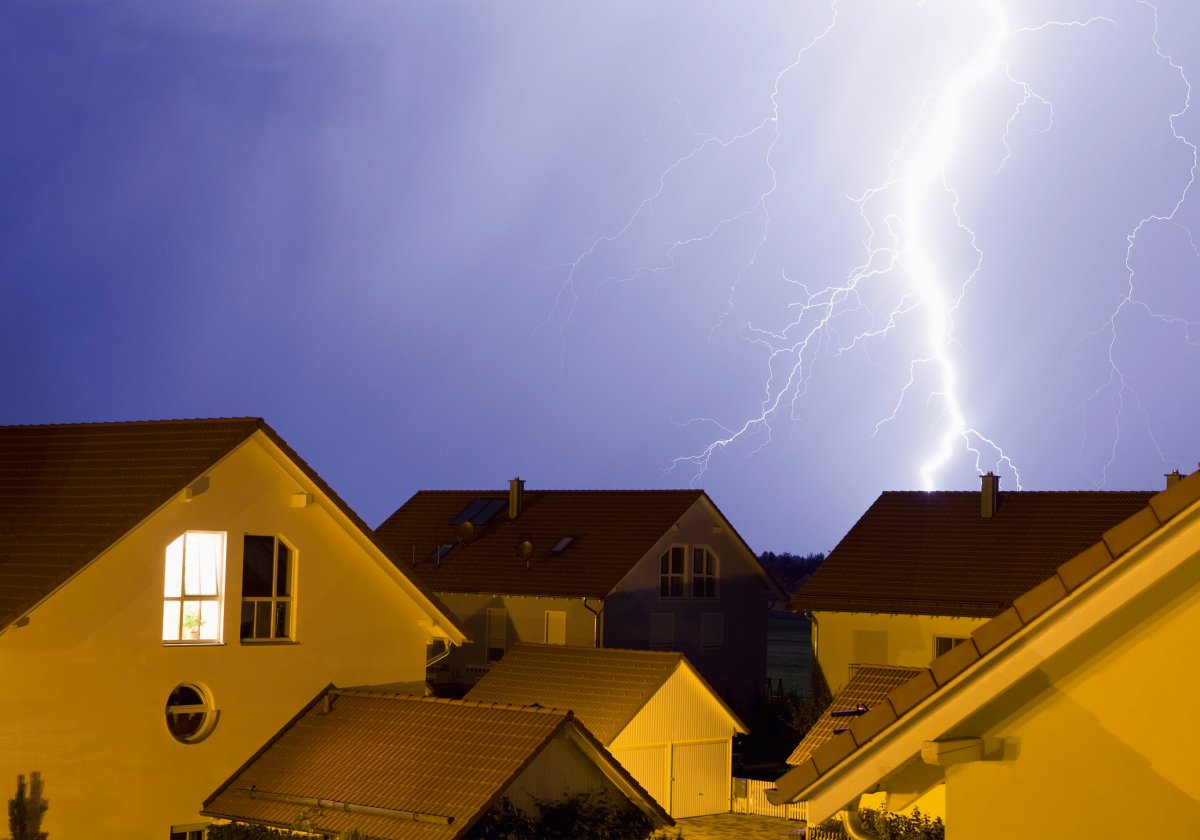

We may earn revenue from the products available on this page and participate in affiliate programs. Learn More ›
Dealing with a power outage is bad enough, but imagine if some of your appliances and electronics didn’t turn on again once the electricity was restored. A power surge, which is a sudden spike in voltage in a home’s electrical system, can damage or destroy any device that relies on electricity to operate. This possibility encompasses a refrigerator and microwave oven in the kitchen, a washing machine and dryer in the laundry room, and even televisions and computers throughout the home. A power surge from a severe storm with lightning can trigger an expensive inconvenience.
One of the best ways to protect your devices is to use a surge protector. Often mistaken for a power strip that allows multiple devices to receive power from a single outlet, a surge protector is a safety device that protects electrical and electronic equipment from damage such as overheating and burning out circuits, which can occur during a power surge.
However, surge protectors degrade over time, ultimately making them ineffective. This can result in your devices being damaged or destroyed. We spoke to several industry experts to find out how to tell if your surge protector is working properly, where to dispose of dead surge protectors, and other steps you can take to safeguard valuable equipment if a surge protector fails.

Why It’s Crucial to Check Your Surge Protectors
Surge protectors can help protect electrical devices. “Good quality surge protection is vital because it helps you protect home electronics, especially as homes become more electrified,” says Dan Carnovale, director of experience centers at Eaton, an international intelligent power management company that makes electrical solutions for homes. “Many homes can have well over $20,000 in electronic equipment, including refrigerators, HVAC systems, televisions, and considerably more if you own an electric vehicle, which means you can have a lot at risk from a surge or momentary voltage transient,” says Carnovale.
Eduard Mirzoian, CEO of Restorerz-Emergency Services in California, has seen how devastating storms can be when surge protectors fail, so he urges all homeowners to check surge protectors regularly and replace them as needed. “This simple habit can help prevent major damage from power surges and keep your home safe and secure, giving you that really important peace of mind,” he says.
Make sure what you’re looking at is actually a surge protector and not just a power strip. It’s important to understand that not all power strips have surge protection, says Carnovale. “Power strips with surge protection should have indicator lights that let you know that your equipment is protected,” he says. “Otherwise, power strips simply allow you to plug more things into a single outlet without offering surge protection.”

How to Tell if Your Surge Protectors Are Working Properly
Surge protectors typically last about 3 to 5 years, but frequent surges can shorten their lifespan, says Tim Hodnicki, president of Electrical Experts, an electric company in Easthampton, Massachusetts. That’s why it’s important to keep an eye on them to make sure they are working correctly, especially once the storm ends and the power is restored.
Hodnicki suggests checking the indicator light first. “If the light is off or flickering, it likely means the device has worn out and can no longer safeguard against power surges,” he says. Also, look for signs of damage like burn marks, melted plastic, or a strange burn-like smell. “These can indicate the protector has taken a surge hit or has overheated and can’t provide reliable protection anymore.” Also, if you notice any buzzing or unusual sounds from the surge protector, this could mean its internal components have been damaged and need to be replaced.
Another red flag is if any connected devices start acting erratically or shutting off. This could mean the surge protector isn’t working anymore. “If you are ever unsure, reaching out to an electrician for a professional inspection is a good option, as we can confirm if the surge protector still has the capacity to handle surges,” says Hodnicki.

Where to Dispose of Dead Surge Protectors
If all the indicators point to a surge protector no longer working, you’ll want to dispose of it safely and replace it with a new one as soon as possible. Don’t throw it out in the regular trash. “Like other electronic equipment, a surge protection device should be recycled at the end of its life,” says Carnovale. “This equipment includes copper and other materials that can be reclaimed, advancing a circular economy,” he says.
“A lot of local recycling centers accept e-waste and offer drop-off points specifically for electronics like surge protectors,” notes Honicki. He also suggests checking at stores like Best Buy and Staples, which have electronics recycling programs and typically accept used or broken surge protectors at no charge.
How to Safeguard Valuable Equipment if a Surge Protector Fails
It’s always a good idea to have a backup plan in case the surge protector doesn’t do the job. Look for a surge protector with an auto-shutoff feature to prevent the device from putting out power when it’s no longer functioning.
For enhanced safety, think about setting up a whole-home surge protection system installed at the main electrical panel to prevent damage to the wiring throughout your home as well as appliances and home electronics, recommends Mirzoian. “It’s a solid investment that has more comprehensive protection for your important devices like televisions and computers—especially if you live in an area open to regular storms. This step can save you from the hassle and cost of repairs or replacements down the road.”
Another option is to install an uninterruptible power supply (UPS) with built-in surge protection that offers a battery backup to keep equipment like your computer running long enough for you to shut it down properly.
